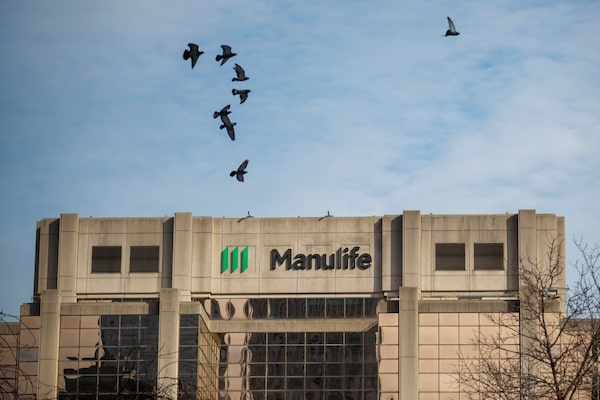
Manulife Financial Corp. raised its payout by 5 cents a share, to 33 cents, underscoring the ability, and willingness, of financial firms to make up for missed dividend hikes during most of the pandemicCole Burston/The Canadian Press
Dividend hikes from Canadian banks and insurers are coming. The question is whether share prices will rally on the good news.
After Manulife Financial Corp. boosted its quarterly dividend by a dazzling 18 per cent on Friday, investor attention naturally turned toward what other insurers and banks will do now that the financial regulator has given them the green light for the first time in more than a year and a half.
In March, 2020, the Office of the Superintendent of Financial Institutions (OSFI) prohibited dividend hikes and share buybacks by financial institutions as a way of blunting the economic risks posed by the pandemic. But the economy has been healing, employment is recovering and loan losses have subsided. The regulator announced on Thursday that it was lifting the restrictions immediately.
With its new-found freedom, Manulife raised its payout by 5 cents a share, to 33 cents. That’s an impressive boost that underscores the ability, and willingness, of financial firms to make up for missed dividend hikes during most of the pandemic. It also marks an upbeat note for investors counting on payouts from other players.
In a note released on Thursday before Manulife announced its hike, Darko Mihelic, an analyst at RBC Dominion Securities, said he thought the insurer could hypothetically increase its payout by 12 per cent to 31 cents a share. This increase would have returned Manulife’s payout ratio – which compares the annualized dividend with profits – to the midpoint of its target range of 30 per cent to 40 per cent.
The actual dividend increase, though, will lift Manulife’s payout ratio marginally above the upper end of this target range, according to analysts. If other financial institutions follow this lead, dividend hikes could be impressive, given that most payout ratios are currently well below target ranges.
Bank of Montreal , for example, has a target payout ratio of 40 per cent to 50 per cent, which is typical for the Big Six banks. But BMO’s current payout ratio sits well below this target, at just 33 per cent, according to National Bank Financial. Royal Bank of Canada’s payout ratio is 38 per cent.
Since payouts haven’t budged during the pandemic, banks and insurers have seen their cash stockpiles grow well past regulatory thresholds.
Gabriel Dechaine, an analyst at National Bank Financial, said he is expecting an average dividend increase of 18 per cent for the Big Six Banks and 23 per cent for life insurance companies. His estimates are based on the expectation that these firms will raise their dividends to the midpoints of target payout ratios.
“What remains to be seen is whether companies deliver ‘one and done’ dividend hikes, or if they pace out the increases over several quarters. In our view, the second scenario is more likely,” Mr. Dechaine said in a note on Thursday.
That’s because financial firms face a potential backlash if they are seen as being too generous to shareholders at a time when governments are struggling with enormous deficits and consumers are confronting surging inflation and higher borrowing costs.
For this reason, and because the OSFI has said it expects companies to act with “humility and prudence” now that it has lifted restrictions, some analysts believe financial firms could be cautious about raising their dividends or announcing share buybacks.
Manulife’s shareholder-friendly dividend hike might raise expectations. Unfortunately, the stock market’s reaction was relatively ho-hum.
On Friday, Manulife’s share price jumped as much as 2.9 per cent in early trading, but ended the day up just 1.4 per cent. The shares closed in Toronto at $24.37, up 33 cents.
Worse, the Big Six banks fell on average by about 0.2 per cent on Friday, lagging the broad S&P/TSX Composite Index.
While the prospect of dividend hikes is undoubtedly good news for investors, financial stocks have enjoyed impressive rallies this year, suggesting a lot of good news has been priced in.
The Big Six are up by an average of 33 per cent in 2021, or nearly 10 percentage points more than the TSX over the same 10-month period. The gains have sent the average bank dividend yield below 3.5 per cent, from about 4.4 per cent in January.
Dividend hikes will lift that yield nicely. Stock prices are counting on it.
Be smart with your money. Get the latest investing insights delivered right to your inbox three times a week, with the Globe Investor newsletter. Sign up today.